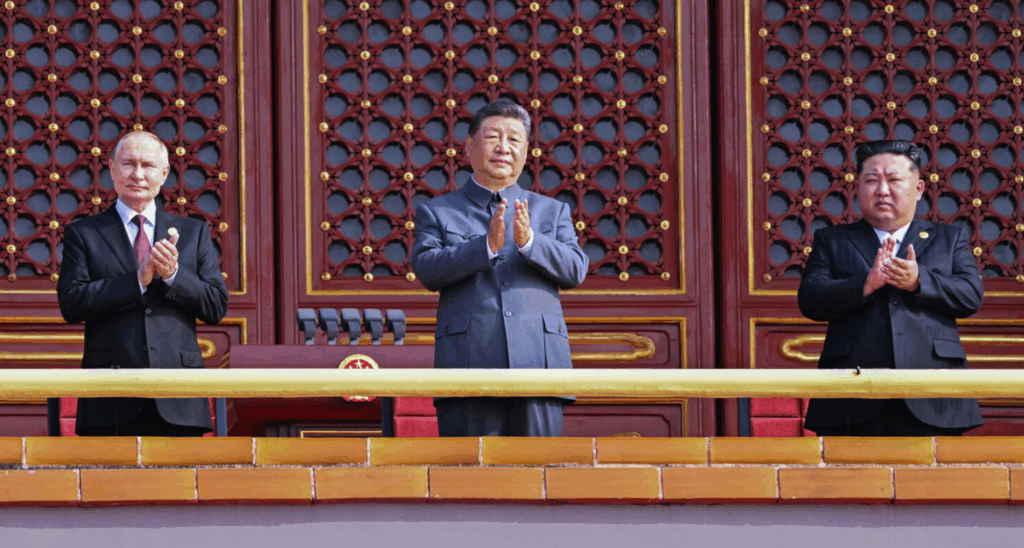The Peninsula
Beijing Parade Underscores the New Divide on the Korean Peninsula

On September 3, the leaders of China, North Korea, and Russia attended a military parade in Beijing, China, to mark the eightieth anniversary of China’s Victory Day. Their meeting received global attention as the top leaders of the three countries reunited for the first time in sixty-six years at the very same Tiananmen Square, where Chinese President Mao Zedong, Soviet General Secretary Nikita Khrushchev, and North Korean President Kim Il Sung once stood together in 1959.
This event took place immediately after South Korean President Lee Jae Myung held summit meetings with Japanese and U.S. leaders, laying the groundwork for strengthening U.S.-South Korea-Japan trilateral cooperation and promoting the resumption of U.S.-North Korea talks. Given that, the sight of President Xi Jinping walking alongside Russian President Vladimir Putin and North Korean Chairman Kim Jong Un in Tiananmen Square was seen as a defiant move to display trilateral solidarity against the United States and to pressure the Donald Trump administration. Their gathering also represented a formalized new Cold War structure surrounding the Korean Peninsula—with the United States, South Korea, and Japan on one side and China, North Korea, and Russia on the other—and the further entrenchment of the divide between democracy and authoritarianism.
Whether the Xi-Kim-Putin meeting will be a one-time event or evolve into a trilateral cooperative framework in the future remains to be seen. However, considering the fact that the leaders of the United States, South Korea, and Japan first met on the sidelines of a multilateral event before the Camp David summit, this Xi-Kim-Putin meeting should not be taken lightly.
Despite North Korea’s reclusive nature, what motivated Kim’s first participation in a multilateral meeting since taking power in 2012? First, by appearing next to Xi and Putin, the North Korean leader wanted to show both domestic and international audiences that his country has joined the ranks of nuclear powers like China and Russia. This could serve as domestic propaganda to help strengthen the regime’s internal control and legitimacy, claiming that Kim’s achievements surpass the legacy of his predecessors. At the same time, North Korea wanted to make clear that it has no intention of giving up its nuclear weapons program. Second, amid U.S.-Russia negotiations to end the war in Ukraine, North Korea sought to improve relations with China as a strategic move to maximize economic aid from China and military cooperation from Russia. Third, North Korea’s diplomatic overture was also aimed at diverting and easing pressure from U.S.-South Korea-Japan cooperation by seeking solidarity between China, North Korea, and Russia. Finally, Kim is seeking to reset the terms of negotiations with the United States in his favor by meeting with Chinese and Russian leaders and garnering their support before the possible resumption of U.S.-North Korea talks.
In Washington, resuming dialogue with Pyongyang hinges entirely on President Trump’s will. Many within the Trump administration want to focus on China after ending the ongoing war in Ukraine. With the midterm elections looming next year, Trump may seek foreign policy accomplishments to showcase to the domestic audience. Furthermore, given his expressed desire to win the Nobel Peace Prize, he may be reluctant to engage in diplomatic interventions that are certain to fail. Therefore, if North Korea proposes talks for a peace treaty or nuclear disarmament during a moment where there is no progress in the Ukraine peace talks, there is a chance that Trump’s attention could shift to North Korea. This is why North Korea’s recent assertion that “for our nuclear policy to change, the world must change, and the political and military environment on the Korean Peninsula must change” is drawing attention.
For the South Korean government, the current situation demands a longer-term approach aimed at creating opportunities to resume dialogue with North Korea. Since taking office, the Lee administration has tried to create an environment conducive to dialogue with North Korea through preemptive measures and a summit with President Trump. However, the reality is that North Korea wants to bypass the South Korean government and prefers direct negotiations with the Trump administration. In preparation for future dialogue with North Korea, President Lee, who has vowed himself as a “pacemaker,” must maintain close policy coordination with the Trump administration to avoid creating a vacuum in the alliance.
This article was originally published in the Hankook Ilbo on Saturday, September 6, 2025. The Korean version of the article is available at https://www.hankookilbo.com/News/Read/A2025090416290004767 .
Ellen Kim is Director of Academic Affairs at KEI.
Photo from KCNA.
KEI is registered under the FARA as an agent of the Korea Institute for International Economic Policy, a public corporation established by the government of the Republic of Korea. Additional information is available at the Department of Justice, Washington, D.C.
